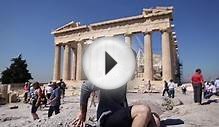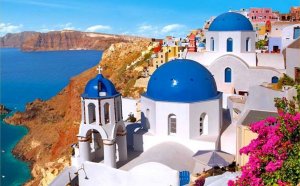
Athens sites
|
The Pnyx |
||
|
The Pnyx was the official meeting place of the Athenian democratic assembly (ekklesia). In the earliest days of Athenian democracy (after the reforms of Kleisthenes in 508 B.C.), the ekklesia met in the Agora. Sometime in the early 5th century, the meeting place was moved to a hill south and west of the Acropolis. This new meeting place came to be called "Pnyx" (from the Greek word meaning "tightly packed together". Three phases can be distinguished:
Pnyx I: Probably constructed in the early 5th century. The people apparently sat on the hillside facing a speaker's platform on the north. The seating capacity may have been anywhere from 6000 to 13, 000 people. This phase is represented archaeologically only by a few cuttings in the bedrock and a boundary stone (not found in situ), so that it is impossible to determine the date and size with any precision. Pnyx II: Probably late 5th century B.C. In this phase the orientation of the auditorum was apparently reversed (a recontruction that is based more upon ancient literary sources than from the actual archaeological record). A stepped terrace wall was created on the north to support an artificial terrace, and the people sat facing a speaker's platform on the south. Part of the stepped terrace wall is preserved, as well as a staircase with rock-cut steps leading up to it from the direction of the Agora. The size of the auditorium (as it is restored by the excavators) is not that much larger than Pnyx I. Pnyx III: The Pnyx was rebuilt and expanded in the 3rd quarter of the 4th century B.C., probably around 345-335 B.C. A massive, curved, retaining wall was built (or at least begun) on the north. The southern side of the auditorium and speaker's platform (bema) were quarried out of the natural bedrock. (Traces of the quarrying process can still be seen at the eastern side of the great rock-cut scarp). On a terrace above (south of) the speaker's platform, the foundations were begun for 2 long stoas (but these seem never to have been finished). It is unknown for how many years Pnyx III was used as the meeting place of the ekklesia, and certainly by the 1st century B.C. the the assembly held their meetings in the Theater of Dionysos on the South Slope of the Acropolis. Finally, in the Roman period, part of the Pnyx was used as a sanctuary of Zeus Hypsistos. Evidence for the sanctuary consist of c. 50 niches for votive plaques cut into the bedrock scarp east of the speaker's platform. Many of the votive plaques are carved with representations of human body parts (eyes, breasts, etc.), suggesting that this Zeus Hypsistos was a healing divinity. Browse the Image Catalogue (click on any thumbnail to view larger image) Select Bibliography:
|
RELATED VIDEO



Share this Post
Related posts
Greek destinations
Pulling in more than 13 million tourists every year, Greece is one of the world’s most popular holiday spots. And it’s not…
Read MoreGreek Island Hopping Vacation Packages
After an early breakfast you will be collected from your hotel for your tour of Athens. See the sights from the comfort on…
Read More










